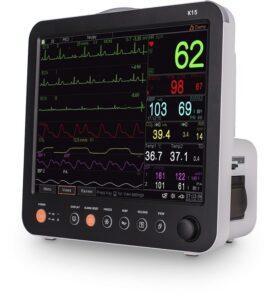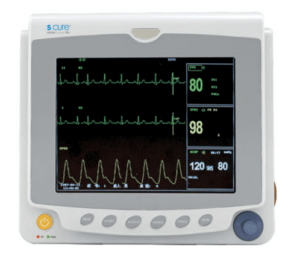In this blog, we will explore the various aspects of Patient Monitoring Systems, from their importance and different types to the advancements in real-time monitoring, wireless technology, and integration with electronic medical records (EMRs). Additionally, we will delve into specialized applications in cardiac care, respiratory support, neonatal monitoring, and the significance of data security and privacy. Furthermore, we will uncover the transformative potential of artificial intelligence (AI) in patient monitoring systems. Join us on this journey as we unlock the power of patient monitoring systems and envision a future of enhanced healthcare delivery.
Understanding the Importance of Patient Monitoring Systems
Patient monitoring systems have become indispensable in modern healthcare, playing a vital role in monitoring and caring for patients. They facilitate remote monitoring, benefiting patients who require ongoing care but may not need to be hospitalized. This reduces the need for frequent hospital visits, enhances patient convenience, and improves overall patient comfort. Patient monitoring systems are essential tools in modern healthcare that provide continuous monitoring, early detection of abnormalities, remote monitoring capabilities, and data-driven insights. By enabling timely interventions, optimizing patient care, and enhancing patient safety, these systems contribute to improved treatment outcomes and more efficient healthcare delivery.
Unveiling Different Types of Patient Monitoring Systems
Patient monitoring systems play a crucial role in the healthcare industry, offering a range of innovative technologies to continuously track and assess patients’ vital signs.
- Cardiac Monitoring Systems: Cardiac monitoring systems focus on monitoring the heart’s electrical activity and overall cardiovascular health. Cardiac monitoring systems are instrumental in diagnosing and managing cardiovascular conditions, enabling healthcare providers to deliver timely interventions and optimize patient care.
- Respiratory Monitoring Systems: Designed to assess and monitor respiratory function, these systems measure parameters like oxygen saturation and respiratory rate. They help detect respiratory distress and optimize ventilator settings.
- Neonatal Monitoring Systems: Specially designed for newborn infants, these systems track vital signs to ensure early detection of health issues and promote optimal neonatal health.
- Neurological Monitoring Systems: Neurological monitoring systems focus on assessing and monitoring brain function and neurological activity.
- Blood Pressure Monitoring Systems: These systems measure and track blood pressure levels, crucial for assessing cardiovascular health and managing hypertension.
- Temperature Monitoring Systems: Employed to continuously measure body temperature, these systems are vital in critical care settings for detecting changes that may indicate underlying health conditions or infections.
- Remote Monitoring Systems: Remote monitoring systems have become particularly valuable in home healthcare settings, enabling patients to receive continuous care while minimizing the need for frequent hospital visits.
Understanding the various types of patient monitoring systems empowers healthcare professionals to deliver timely interventions, optimize patient care, and improve outcomes. Each type serves a unique purpose, catering to specific medical needs and enabling personalized care for patients.
Revolutionizing Healthcare with Wireless Monitoring
Wireless monitoring is transforming the healthcare landscape by offering unprecedented freedom and flexibility to both patients and healthcare providers. By eliminating the constraints of traditional wired monitoring systems, wireless technology allows patients to move freely within healthcare facilities without being restricted by cables and wires, enhancing their comfort and overall experience.
This remote monitoring capability empowers healthcare providers to monitor patients outside the confines of traditional healthcare settings and make timely, informed decisions. Furthermore, wireless monitoring systems can be integrated with electronic health records (EHR) systems, facilitating seamless data exchange and comprehensive patient care coordination. Wireless monitoring not only enhances patient comfort but also enables remote monitoring, telemedicine, and virtual consultations. This instant access to critical patient information leads to improved patient outcomes and personalized care.
Enhancing Cardiac Care with Patient Monitoring Systems
Patient monitoring systems have revolutionized cardiac care by providing healthcare professionals with valuable insights into the cardiovascular health of patients. These advanced systems are specifically designed to monitor and assess various cardiac parameters, enabling healthcare providers to detect abnormalities, manage cardiac conditions, and optimize treatment strategies. By closely monitoring these vital signs, healthcare professionals can detect any irregularities or fluctuations that may indicate underlying cardiac issues.
These monitoring systems offer several benefits in cardiac care. First and foremost, they enable healthcare providers to assess the effectiveness of cardiac medications and interventions in real time. By monitoring the patient’s response to treatment, healthcare professionals can make timely adjustments and ensure optimal therapeutic outcomes. Patient monitoring systems also aid in the prevention of adverse events by providing continuous surveillance and alarm systems. In critical situations, these systems trigger alarms when vital signs deviate from the normal range, alerting healthcare professionals to potential emergencies. They have significantly enhanced cardiac care by providing continuous, accurate, and real-time monitoring of crucial cardiac parameters. With their ability to detect abnormalities, optimize treatments, and improve patient outcomes, these systems have become indispensable tools in modern cardiac healthcare settings.
Improving Respiratory Care with Patient Monitoring Systems
Improving respiratory care is a critical aspect of healthcare, and patient monitoring systems have emerged as valuable tools for managing respiratory conditions effectively. These advanced systems play a pivotal role in monitoring respiratory parameters, providing healthcare providers with real-time data to assess lung function and identify potential respiratory distress. By closely monitoring parameters such as oxygen saturation, respiratory rate, and end-tidal carbon dioxide levels, patient monitoring systems enable healthcare professionals to make informed decisions and deliver prompt interventions when necessary.
Patient monitoring systems help optimize respiratory care plans by providing valuable data for adjusting treatment strategies and ventilator settings. By monitoring trends and changes in respiratory parameters, healthcare providers can assess the effectiveness of interventions and make timely adjustments to ensure optimal respiratory support. These systems also assist in assessing the response to therapies, guiding healthcare professionals in tailoring treatments to individual patients’ needs. They have significantly improved respiratory care by offering continuous and non-invasive monitoring, facilitating early detection of respiratory distress, and enabling personalized treatment strategies.
Safeguarding Patient Data in Monitoring Systems
Here are some techniques and practices implemented to safeguard patient data in monitoring systems:
- Encryption: Utilize strong encryption algorithms to protect sensitive patient data during transmission and storage. Encryption converts the data into unreadable ciphertext, making it inaccessible to unauthorized individuals.
- Access Control: Implement robust access control mechanisms to restrict system access to authorized personnel only. This includes user authentication, role-based access controls, and secure login procedures to prevent unauthorized access to patient information.
- Data Minimization: Collect and store only necessary patient data, minimizing the risk associated with storing excess information. Regularly review and purge outdated or unnecessary data to reduce the attack surface and potential exposure.
- Regular System Updates and Patching: Apply timely updates and security patches to operating systems, software, and monitoring devices to address vulnerabilities and protect against emerging threats.
- Staff Training and Awareness: Conduct regular training sessions to educate healthcare staff about the importance of data security, proper handling of patient information, and identifying potential security risks. Promote a culture of data privacy and security awareness throughout the organization.
By implementing these safeguarding techniques, healthcare organizations can significantly enhance the security and privacy of patient data within monitoring systems, maintaining patient trust and confidentiality while delivering quality healthcare services.
Harnessing the Power of AI in Patient Monitoring
Artificial intelligence is revolutionizing patient monitoring in the medical industry, transforming the way healthcare providers collect and interpret patient data. With advanced algorithms and machine learning capabilities, AI-based monitoring systems offer unprecedented insights, improving patient outcomes and optimizing resource allocation. AI empowers healthcare providers to analyze vast amounts of patient data in real time, enabling comprehensive understanding and personalized treatment plans. By processing diverse data streams such as vital signs, laboratory results, and electronic health records, AI algorithms facilitate accurate diagnoses and timely interventions. Moreover, AI algorithms excel at detecting subtle patterns and trends that may go unnoticed by human observers. This early identification of potential complications allows proactive interventions, minimizing risks and improving patient safety.
AI in patient monitoring is a powerful tool that augments healthcare providers’ decision-making capabilities. It offers real-time analysis, predictive analytics, and remote monitoring, ultimately leading to more efficient, personalized, and proactive patient care. With its potential to revolutionize healthcare delivery, AI represents a promising frontier in the pursuit of improved patient outcomes and enhanced medical practices.
Patient Monitoring Systems from Leading Indian Manufacturers
Phoebus P529
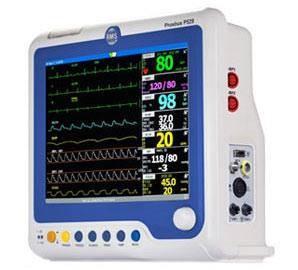 Introducing the Phoebus P529 Patient Monitoring System by Recorders & Medicare Systems Pvt. Ltd. (RMS India). This advanced system helps improve clinical performance and enhance patient care. Phoebus multiparameter patient monitors are available in various configurations, from ultra-portable single-parameter models to high-end multiparameter models. They analyze ECG, NIBP, SPO2, RESP, IBP, ETCO2, and TEMP parameters, offering features like arrhythmia detection, alarm facility, and real-time ST segment analysis. With drug dose calculation, sidestream and mainstream capnography, electrocautery and defibrillator protection, and a high-resolution color display, the Phoebus P529 ensures accurate monitoring and prompt alerts. It also provides trends display, graphical and tabular trends storage, wave review, and compatibility with Android CMS.
Introducing the Phoebus P529 Patient Monitoring System by Recorders & Medicare Systems Pvt. Ltd. (RMS India). This advanced system helps improve clinical performance and enhance patient care. Phoebus multiparameter patient monitors are available in various configurations, from ultra-portable single-parameter models to high-end multiparameter models. They analyze ECG, NIBP, SPO2, RESP, IBP, ETCO2, and TEMP parameters, offering features like arrhythmia detection, alarm facility, and real-time ST segment analysis. With drug dose calculation, sidestream and mainstream capnography, electrocautery and defibrillator protection, and a high-resolution color display, the Phoebus P529 ensures accurate monitoring and prompt alerts. It also provides trends display, graphical and tabular trends storage, wave review, and compatibility with Android CMS.
BM-K15
The BM-K15 by Bird Meditech is a top-notch Patient Monitoring System in India. It offers a 12.1″ LED backlight display, showing up to 9 waveforms simultaneously. It monitors ECG, respiration, SpO2, PR, NIBP, temperature, 2-IBP, EtCO2, Nellcor SpO2, SunTech NIBP, 12-lead ECG, cardiac output, and cerebral state. With customizable NIBP cycles, it adapts to patient needs. The device can display up to 13 waveforms, and data can be exported or upgraded. It features a 360-degree visible indicator with 3-level alarms and a Li-ion battery for 2.5 hours of monitoring. The BM-K15 also integrates a thermal recorder. It is a reliable and versatile patient monitoring system.
Macflav 3000A
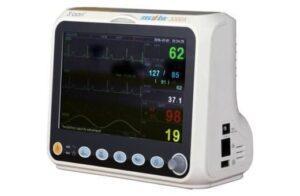 STAAN Bio-Med Engineering Private Limited‘s Macflav 3000A is a user-friendly critical care device. As India’s leading manufacturer, it provides constant medical support. The device monitors up to 8 parameters, offers a display option, and has 3-5 channel waveforms. It is defibrillator-proof tested and includes an alarm with a unique design. The Macflav 3000A comes with a large data storage capacity and has the option for printer and central monitoring.
STAAN Bio-Med Engineering Private Limited‘s Macflav 3000A is a user-friendly critical care device. As India’s leading manufacturer, it provides constant medical support. The device monitors up to 8 parameters, offers a display option, and has 3-5 channel waveforms. It is defibrillator-proof tested and includes an alarm with a unique design. The Macflav 3000A comes with a large data storage capacity and has the option for printer and central monitoring.
Vizyon M12
 Vizyon M12 by MAX Meditech Pvt. Ltd. (formerly A.B. Industries) is a high-quality patient monitoring system used in operation theaters and intensive care units. With global-scale recognition, it offers Wi-Fi remote monitoring. It features 10 real-time, programmable displays and easy navigation through a single knob. The device is noticeable even while moving and has a night mode feature. With a big font size and recognizable visual vital signs alarm, it ensures improved visibility. The Vizyon M12 can display up to ten waveforms, including temperature, IBP/EtCO2, pulse rate, SpO2, NiBP with MAP Resp., and NiBP. It stores NiBP trends at 3500 readings and other parameters at 256 hours.
Vizyon M12 by MAX Meditech Pvt. Ltd. (formerly A.B. Industries) is a high-quality patient monitoring system used in operation theaters and intensive care units. With global-scale recognition, it offers Wi-Fi remote monitoring. It features 10 real-time, programmable displays and easy navigation through a single knob. The device is noticeable even while moving and has a night mode feature. With a big font size and recognizable visual vital signs alarm, it ensures improved visibility. The Vizyon M12 can display up to ten waveforms, including temperature, IBP/EtCO2, pulse rate, SpO2, NiBP with MAP Resp., and NiBP. It stores NiBP trends at 3500 readings and other parameters at 256 hours.
MP 8400 Multi Para Monitor
Silverline Meditech Pvt. Ltd. manufactures the MP 8400, a versatile multi-parameter monitor suitable for adult, pediatric, and neonatal patients. It has an 8.4″ color TFT display and offers high-resolution ECG waveforms of 7 leads on the same screen. The monitor features audible and visual alarms, AC to DC Adapter, and drug calculation capabilities. It comes with a built-in rechargeable lithium battery and offers 72 hours of graphic and tabular trends for all parameters. The MP 8400 stores 71 alarm events and has a full disclosure waveform review of 32 seconds. It also supports optional upgradeable features and central monitoring with LAN networking or wireless VGA output.
TruSKAN S600
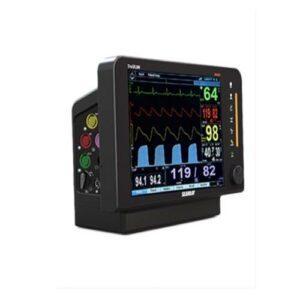 Skanray Technologies Ltd.‘s TruSKAN S600 is a high-quality 6-channel patient monitoring system. With its 12.1″ TFT color display, it provides comprehensive monitoring of ECG, respiration, dual temperature, NIBP, dual IBP, SpO2, and micro stream EtCO2. It offers advanced features like SatSeconds™, LoSat™, and IPI™. The TruSKAN S600 supports wired and wireless connectivity to Skanray’s Central Nursing Station, allowing seamless networking capabilities. It also provides vital trends and storage for up to 168 hours. The monitor has a user-configurable layout with multiple selections and features ST segment analysis and arrhythmia analysis as standard.
Skanray Technologies Ltd.‘s TruSKAN S600 is a high-quality 6-channel patient monitoring system. With its 12.1″ TFT color display, it provides comprehensive monitoring of ECG, respiration, dual temperature, NIBP, dual IBP, SpO2, and micro stream EtCO2. It offers advanced features like SatSeconds™, LoSat™, and IPI™. The TruSKAN S600 supports wired and wireless connectivity to Skanray’s Central Nursing Station, allowing seamless networking capabilities. It also provides vital trends and storage for up to 168 hours. The monitor has a user-configurable layout with multiple selections and features ST segment analysis and arrhythmia analysis as standard.
Conclusion
Patient monitoring systems have revolutionized healthcare by providing real-time data and valuable insights for improved patient care. These systems play a vital role in cardiac care, respiratory care, neonatal care, and more, enabling early detection of abnormalities and prompt intervention. With advancements in wireless technology, data security, and AI integration, patient monitoring systems continue to enhance accuracy, efficiency, and patient comfort. To stay ahead in the evolving healthcare landscape, organizations can leverage Medzell, a futuristic B2B platform promoting Indian medical devices in emerging markets. Medzell’s innovative approach facilitates the seamless integration of advanced patient monitoring systems, empowering healthcare professionals to deliver personalized and precise care.

